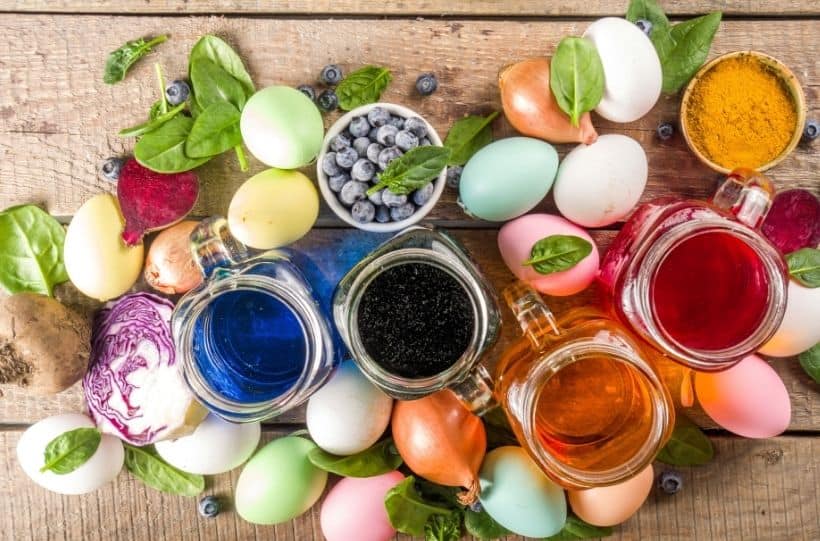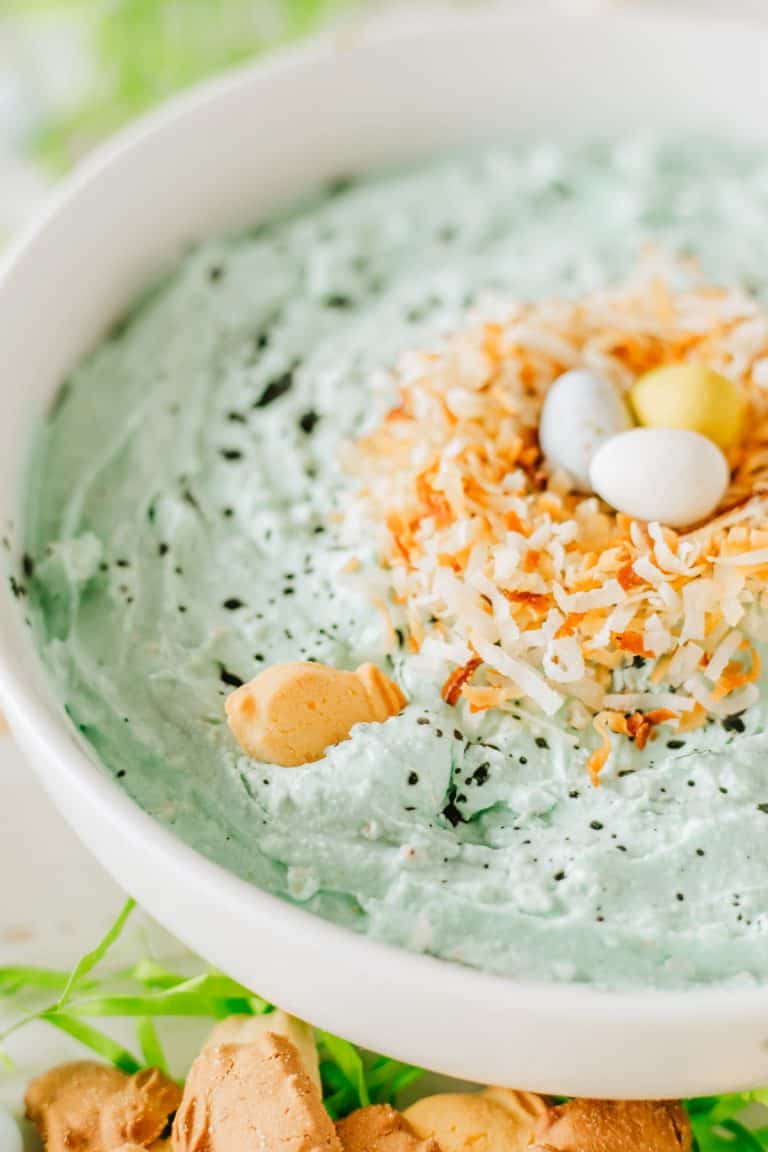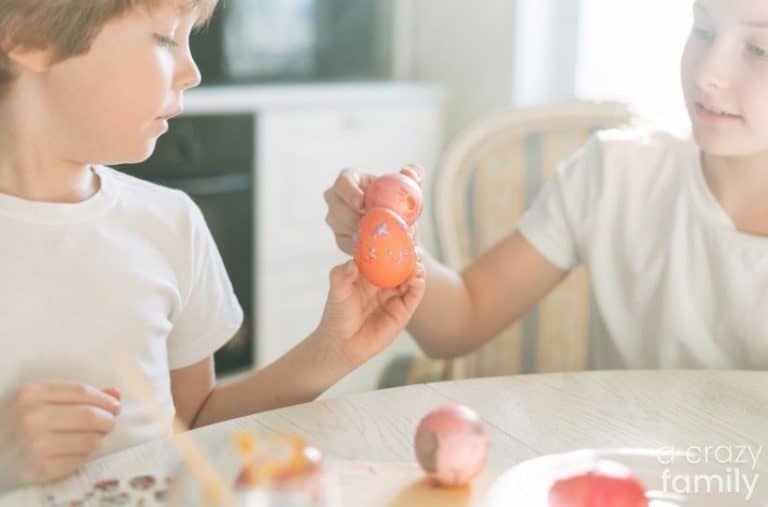Dyeing Easter Eggs With Natural Ingredients
This post may contain affiliate links. Please read our disclosure policy.
Want to see how easy it is to naturally dye your Easter eggs? Find out how you can use paprika, blueberries, and many other ingredients you probably already have in your home as natural dye options to make this a chemical-free activity for your kids.

Creative ideas for dyeing Easter eggs with natural ingredients
Easter is almost here, and it is time to start thinking about all of the fun and exciting things you can do for Easter with your kids. One of the best things to do during the easter season is to dye easter eggs.
The good news is that you do not have to buy the kits and can instead choose to dye your easter eggs using natural healthy ingredients without wasted packaging for an earth-friendly option.
Why you should dye your easter eggs naturally
If you happened upon this article by accident, you may be wondering why you should put in the effort to dye your easter eggs naturally when you can get cheap easter egg-dying kits just about anywhere.
The truth is it is well worth putting in the work to naturally dye your easter eggs because this is much better for the environment, reduces your family’s exposure to harmful chemicals, including those used in commercial food dyes, and can be an amazing educational experience for your child.
Natural ways to dye your easter eggs
There are many great ways you can dye your easter eggs using natural things available to you, from fruits and vegetables to spices. You can make a wide range of great options for a whole rainbow of eggs.
Red Cabbage
One of my favorite options for naturally dying easter eggs is red cabbage. You can boil chopped red cabbage in a pot for about 30 minutes.
Use this juice on its own for a pretty light pink shade. Add vinegar, and you will get a beautiful blue color from the same batch of dye. Use this for the pale pink, then add vinegar to get blue eggs.
Turmeric
We all know turmeric will stain just about anything a bright yellow color. Add a tablespoon of turmeric to a cup of water and mix well.
To help the color stick, you can add a tablespoon of white vinegar to help the color stick. The longer you leave your eggs in the turmeric, the brighter the color will be.

Blueberries
Blueberries are more purple than blue, but they can give you a stunning egg color. Mash a cup of blueberries and mix them with 1 cup of water. Add 1 tablespoon of white vinegar and dip your eggs in the dye for a few hours to achieve a subtle blue/purple shade.
Raspberries
Anyone that has ever gone raspberry picking knows just how much it stains your hands. To make an easter egg dye out of raspberries, mash a cup of raspberries and mix them with 1 cup of water. Add 1 tablespoon of white vinegar and dip your eggs in the dye for a few hours to achieve a beautiful dark pink shade.
Beets
Grate 1 beet and add it to a pot of water. Boil the mixture for 10 minutes and add 1 tablespoon of white vinegar. Dip your eggs in the dye for a few hours to achieve a deep pink or purple hue.

Coffee
Brew a strong cup of coffee and add 1 tablespoon of white vinegar. Dip your eggs in the dye for a few hours to achieve a beautiful light brown color.
The stronger the coffee and the longer you let it sit, the darker your brown will be.
Liquid chlorophyll
If you have ever spilled this concentrated green liquid, you know just how well this is at dying things you do not intend to. The good news is that you can use it to dye your easter eggs a nice dark green. The more water you add, the lighter the green you will get as a result.
Onion Skins
Save the outer skins of yellow or red onions and place them in a pot of water. Boil the mixture for 30 minutes and add 1 tablespoon of white vinegar. Dip your eggs in the dye for a few hours to achieve a beautiful orange or brown color.
Paprika
Mix 2 tablespoons of paprika with 1 cup of water. Add 1 tablespoon of white vinegar and dip your eggs in the dye for a few hours to achieve a beautiful orange color.
Add some flare to your naturally decorated eggs
There are some fun and creative ways you can take your easter eggs up a notch over simply dying your easter eggs. These simple natural options can help make your easter eggs fun and unique.
Creating amazing combinations
There is no reason you can not have fun with this and use multiple colors on one egg. If you have ever dyed easter eggs with young kids, you know that they tend to take an egg from one bowl and move it to another, creating new and unique colors, eggs that are a mix of two or three different colors in layers and all kinds of other combinations.
Add some specks
Brew a strong cup of black tea and add 1 tablespoon of white vinegar. Dip your eggs in the dye for a few hours to achieve a light brown color with subtle speckles.
You can control how these speckles land by placing wet tea leaves or coffee grounds on your eggs and letting them sit for an hour or so.
Use a white crayon
You can draw designs and shapes on your easter eggs using white crayons. Then when you dip your eggs in the dye, the design will be revised because the dye can not deposit under the wax. This is a fun way to customize eggs with names, shapes, and personal touches.
Decoupage pressed flowers
One option for naturally decorating your easter eggs that tends to impress anyone that sees them is to decorate eggs with pressed flowers. Press your flowers flat. Because your eggs will not be sitting for a long period of time, they do not necessarily need to be dried, though you can also use dried flowers.
Make a sugar glue by mixing together 1 part water with 2 parts sugar and bring to a boil on the stove. Shut off before the sugar begins to caramelize. Use this to attach your flowers to your easter eggs and allow them to dry.






